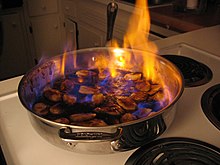Flambé

- Flambé is also a type of ceramic glaze.
Flambé (UK: /ˈflɑːmbeɪ, ˈflɒ̃-/, US: /flɑːmˈbeɪ/,[1][2] French: [flɑ̃be]; also spelled flambe) is a cooking procedure in which alcohol is added to a hot pan to create a burst of flames. The word means "flamed" in French.[3]
Flambéing is often associated with the tableside presentation of certain liqueur-drenched dishes set aflame, such as
History
Modern flambéing became popular in the 19th century. The English
Procedure
The alcoholic beverage must be heated before lighting it on fire. This is because the liquid is still below the flash point at room temperature, and there are not enough alcoholic vapors to ignite. The vapor pressure increases by heating it, releasing enough vapors to catch fire from the match.[11]
Effects on taste
Flambéing reduces the alcohol content of the food modestly. In one experimental model, about 25% of the alcohol was boiled off. The effects of the flames are also modest: although the temperature within the flame may be quite high (over 500 °C), the temperature at the surface of the pan is lower than that required for a Maillard browning reaction or for caramelization.[12]
...we serve almost everything flambe in these rooms, occasionally even a waiter's thumb. The people seem to like it, and it doesn't harm the food much.
—
Whether or not there is a change in flavor as a result of flambéing is unclear. Some claim that because the flame is above the food, and since hot gases rise, it cannot significantly affect the flavor. Indeed, experimental work shows that most people cannot tell the difference.[12] That said, in an informal taste test conducted by the Los Angeles Times of two batches of caramelized apples (one flambéed and one simmered), one tester declared the "flambéed dish was for adults, the other for kids."[10] Others, however, dispute this and quote celebrated French chefs who claim that flambéing is strictly a show-biz aspect of the restaurant business that ruins food but is done to create an impressive visual presentation at a dramatic point in the preparation of a meal.[14]
Jogging
For safety, it is recommended that alcohol not be added to a pan on a burner and that the cook use a long fireplace match to ignite the pan.[9]
Flambé dishes
Examples of popular flambé dishes include:[15]
- Bananas Foster
- Bombe Alaska
- Cherries jubilee
- Christmas pudding
- Crêpes Suzette
- Feuerzangenbowle
- Flaming beverages
- Gundel Palacsinta
- Steak Diane
See also
References
- ISBN 0-550-10105-5.
- ISBN 978-0-521-15255-6.
- ^ flambé is the past passive participle of the verb flamber, to flame
- ISBN 9781420936292.
- ^ Soyer, Alexis (1847). The Gastronomic Regenerator (3rd ed.). Simpkin, Marshall & Company. p. 477. The 1st edition of 1846 has the same recipe.
- ^ Joscelyne, Ida (1880). The Marvellous Little Housekeepers. p. 153.
- ^ Payne, A.G. (1882). Choice Dishes at Small Cost. London: Cassell. p. 235.
- ISBN 978-0-375-75692-4. Retrieved 9 December 2011.
- ^ a b "Flambé". What's Cooking America. Retrieved 9 December 2011.
- ^ a b Scattergood, Amy (December 28, 2005). "Let the Sparks Fly". Los Angeles Times. Retrieved September 1, 2013.
- ISBN 9780124001510. Retrieved 18 September 2012.
- ^ a b Hansen, Christine E.; Misha T. Kwasniewski; Sacks, Gavin L. (2012). "Decoupling the effects of heating and flaming on chemical and sensory changes during flambé cooking". International Journal of Gastronomy and Food Science. Vol. 1, no. 2. pp. 90–95.
- ^ quoted in Jimmy Savage. (February 13, 1950). "Tower Ticker" column, Chicago Tribune, Part 1, p.19
- ISBN 0-252-06875-0.
- ^ "List of Flambé recipes". About.com Home Cooking. Archived from the original on 2011-12-02. Retrieved 2006-11-07.
